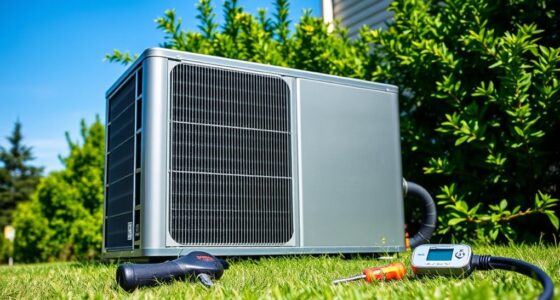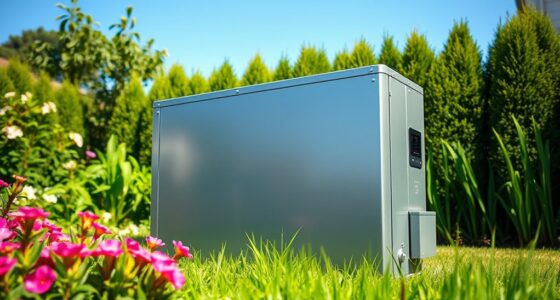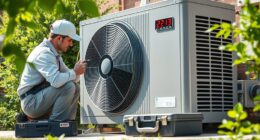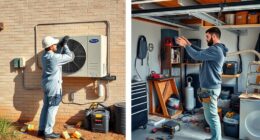The future of heat pump technology is exciting, with innovations like variable speed compressors, smart controls, and low-GWP refrigerants shaping a more efficient and eco-friendly industry. Expect modular designs, AI-driven optimization, and integration with renewable energy sources to become common. Industrial applications will see high-temperature models boosting decarbonization efforts. As regulations tighten and incentives grow, system safety and indoor air quality will also improve. Stay with us to see what’s next in this rapidly evolving field.
Key Takeaways
- Advanced refrigerants like R-32 and R-454B will dominate, balancing efficiency, safety, and low-GWP environmental standards.
- Integration with AI, IoT, and renewable energy sources will optimize performance, indoor air quality, and system responsiveness.
- Modular and scalable designs will enable customizable solutions for residential and industrial applications, reducing costs and downtime.
- High-temperature heat pumps exceeding 80°C will expand industrial use, aiding decarbonization and waste heat recovery efforts.
- Stricter regulations and incentives will accelerate adoption of safer, low-GWP refrigerants and promote innovation in sustainable heat pump technologies.
Emerging Technological Innovations in Heat Pumps

Emerging technological innovations are transforming heat pump technology, making them more efficient, versatile, and environmentally friendly. Variable speed compressors and inverter-driven models adapt seamlessly to changing conditions, boosting efficiency and performance across diverse climates. High-temperature heat pumps now deliver outputs exceeding 80°C, opening new industrial applications like district heating. Advances in refrigerant technology focus on low-GWP options such as R-32 and R-454B, reducing environmental impact without sacrificing performance. Smart control systems leverage algorithms and machine learning to optimize operation dynamically, saving energy and enhancing comfort. Improved heat exchanger design and new materials increase durability and heat transfer efficiency, supporting higher temperature outputs and longer system lifespans. Moreover, ongoing research into regulatory standards ensures that innovations align with environmental and safety requirements, guiding the sustainable development of heat pump technology. Incorporating refrigerant innovations and other advancements collectively push heat pump technology toward a sustainable, high-performance future. Additionally, technological integration plays a crucial role in enabling these innovations to operate synergistically and maximize benefits. Furthermore, advancements in component durability ensure these systems can withstand harsher conditions, extending their operational lifespan and reliability. Also, public awareness and policies are increasingly influencing market adoption and encouraging the development of greener solutions.
Integration of AI and Smart Technologies

The integration of AI and smart technologies is revolutionizing heat pump systems by enabling them to operate more efficiently and adaptively. AI-powered control systems analyze weather forecasts, occupancy patterns, and user behavior to optimize energy efficiency, often boosting performance by up to 30%. Smart heat pumps leverage IoT connectivity for real-time adjustments, enhancing indoor comfort while reducing electricity costs. Additionally, AI facilitates predictive maintenance, detecting issues early and extending system lifespan by 15-20%. These technologies also allow heat pumps to coordinate with renewable energy sources like solar panels and batteries, maximizing clean energy use. Moreover, cybersecurity vulnerabilities associated with connected devices necessitate ongoing security enhancements to protect system integrity. The implementation of automated control strategies further improves system responsiveness and user experience. Incorporating energy management systems can help balance energy loads and further optimize overall efficiency. As the industry advances, the development of interoperable protocols ensures seamless communication among diverse smart components. Furthermore, advances in machine learning algorithms enable these systems to continuously improve their performance over time. Ultimately, AI-driven automation and system optimization are paving the way for fully remotely managed heat pump networks, supporting regional energy grids and decarbonization efforts.
Advances in Refrigerants and Environmental Regulations

As regulations tighten and high-GWP refrigerants face bans, you’ll need to adapt to new standards and materials. Manufacturers are redesigning units to meet safety and environmental requirements, which can pose challenges. Understanding these regulatory impacts is essential for staying ahead in heat pump technology’s shift. Staying informed about refrigerant alternatives and their environmental benefits can help in making future-proof decisions. Additionally, innovations in energy-efficient components are paving the way for more sustainable and compliant heat pump systems. Incorporating alternative refrigerants with low GWP and advancing components that improve efficiency can further support compliance and environmental goals. Moreover, integrating hydrogen energy into heating systems could open new pathways for sustainable heat generation in the future.
Refrigerant Transition Challenges
With environmental regulations tightening, moving to low-GWP refrigerants like R-32 presents both opportunities and challenges for the heat pump industry. The refrigerant shift involves replacing high-GWP options like R-410A, which faces regulatory deadlines restricting sales by 2025-2026. R-32’s lower GWP of 675 makes it an attractive alternative, but its mild flammability raises safety standards and requires updates to building codes. You’ll need to incorporate leak detection systems, proper labeling, and handling procedures to address ignition risks. These changes also impact system design, cost, and repair processes. While switching to alternative refrigerants reduces environmental impact, it demands careful navigation of safety regulations, codes, and standards to ensure both compliance and safety during the shift. Additionally, advancements in refrigerant technology aim to improve efficiency and reduce environmental footprints in line with green living initiatives. Moreover, the development of flammability standards is crucial to ensure safe adoption of flammable refrigerants across the industry. Furthermore, ongoing regulatory developments are likely to influence future refrigerant choices and industry standards, emphasizing the importance of staying informed about evolving policies. Incorporating environmentally friendly refrigerants offers a path toward more sustainable heating and cooling solutions, but it requires balancing environmental benefits with safety considerations.
Regulatory Impact on Design
Regulatory changes are driving significant advancements in refrigerant design, compelling the industry to adopt safer, lower-GWP options like R-32. As environmental safety concerns grow, safety standards are evolving to address flammable refrigerants, leading to updates in building codes that incorporate leak detection, labeling, and charge limits to manage ignition risks. The EPA’s plans to phase out high-GWP refrigerants such as R-410A by 2025 and 2026 accelerate this shift, prompting manufacturers to develop refrigerants aligned with new regulations. These regulatory updates aim to balance environmental benefits with safety, requiring systems to meet stricter safety standards for flammable refrigerants. Staying ahead of these changes is essential to ensure compliance, optimize system performance, and mitigate future costs associated with delayed adoption. Additionally, understanding environmental considerations helps manufacturers and consumers make better-informed decisions in this evolving landscape, especially as regulatory standards continue to tighten worldwide. Incorporating refrigerant safety measures is crucial for adapting to these regulatory trends effectively, and ongoing industry research supports the development of innovative solutions to meet these emerging challenges. Moreover, fostering self-awareness within the industry can lead to more responsible innovation and safer product development.
Modular and Customizable Heat Pump Designs

Modular heat pump designs let you scale and customize systems to fit specific heating and cooling needs. You can easily upgrade parts, reducing costs and downtime, while integrating smart controls and renewable sources. This flexibility guarantees ideal performance across different building types and climate zones. Additionally, incorporating water-efficient features can enhance overall system sustainability and reduce long-term operational costs. Implementing energy-efficient components can further optimize performance and promote environmental benefits. Properly integrating thermal energy transfer principles ensures that these systems operate at peak efficiency and durability, supported by advances in component technology that improve system longevity and reliability.
Flexible Configuration Options
Flexible configuration options are transforming heat pump technology by allowing you to tailor systems to your specific needs. With modular heat pump systems, you can customize capacity, reducing upfront costs and installation time. Here are three key features:
- Flexible configurations — options like ductless mini-splits, multi-zone systems, and combined heating-cooling units suit diverse residential and commercial spaces.
- Plug-and-play components — advanced designs enable easy upgrades and maintenance through standardized interfaces.
- Smart controls and renewable energy integration — customizable designs optimize efficiency, user comfort, and adaptability to renewable sources.
These innovations make heat pumps more versatile, cost-effective, and aligned with your unique climate control requirements, paving the way for smarter, more sustainable heating solutions.
Scalable System Integration
By customizing heat pump designs with plug-and-play components, you can easily upgrade, repair, or expand your system as your needs change. Modular heat pumps facilitate scalable deployment across various building types, from small homes to large industrial facilities. These systems rely on standardized components that enable rapid manufacturing and streamlined system integration. Incorporating smart control systems enhances performance and energy efficiency, allowing seamless coordination with renewable energy sources and storage solutions. Customizable designs support flexibility, making it easier to adapt to evolving demands and integrate demand response capabilities. This approach also promotes grid flexibility by enabling demand management and load balancing. Overall, modular and scalable heat pump solutions simplify expansion, reduce costs, and accelerate adoption, ensuring your system remains efficient and adaptable for future energy landscapes.
Tailored Performance Features
Tailored performance features in heat pump designs allow you to customize capacity and configurations to match your specific building size and climate conditions, boosting efficiency and comfort. With modular heat pumps, you get:
- Flexible components like interchangeable heat exchangers and compressors, enabling scalable upgrades and tailored performance.
- Smart controls that optimize performance based on real-time energy prices and occupancy patterns.
- System flexibility, simplifying maintenance and repair by isolating faulty units, reducing downtime, and enhancing energy efficiency.
These customization options support diverse applications, from residential to industrial, and promote long-term adaptability. As industry trends lean toward modular and configurable solutions, tailored performance features are key to maximizing efficiency, reducing costs, and accelerating decarbonization efforts.
Industrial Applications and Decarbonization Strategies

Industrial heat pumps are becoming a crucial component in decarbonization strategies, especially as their capacity surpasses 200 kW and growth rates exceed 15% annually through 2030. You’ll find these systems increasingly used in sectors like food processing, pulp and paper, and chemicals, driven by decarbonization goals and economic incentives. High-temperature heat pumps, capable of providing process heat above 150°C, are essential for heavy industries such as steel and cement, supporting emissions reduction. These systems deliver 3-5 times higher efficiency at low and medium temperatures compared to traditional boilers, cutting energy consumption. Their integration with renewable energy sources and waste heat recovery enhances decarbonization efforts, making industrial heat pumps indispensable for achieving sustainable, low-emission industrial processes and advancing toward net-zero goals.
Policy Developments and Market Incentives

Policy developments and market incentives are accelerating the adoption of heat pump technology across industries. These initiatives are driving change through regulations and incentives that promote environmentally friendly refrigerants and safety standards. Consider these key developments:
- The EPA plans to ban new sales of heat pumps using high-GWP refrigerants like R-410A by January 2025, pushing manufacturers toward lower-GWP options.
- Over 30 countries and states offer rebates covering more than 70% of installation costs, boosting market dynamics and consumer adoption.
- Governments set ambitious targets, such as Massachusetts aiming for 20 million heat pumps by 2030, supported by regulatory reforms and industry transition efforts.
These policy developments shape industry standards and accelerate the shift toward sustainable, safe, and efficient heat pump solutions.
Infrastructure Upgrades and Grid Resilience

As heat pump adoption accelerates, upgrading electrical infrastructure becomes vital to meet the rising demand and guarantee reliable energy delivery. Strengthening grid infrastructure involves integrating smart grid technologies and energy storage solutions to manage intermittent renewable energy sources effectively. Implementing demand response systems helps balance supply and demand, preventing overloads during peak seasons. To guarantee grid resilience, investments in advanced transmission technology and decentralized energy resources are essential. These upgrades enable a more flexible, stable grid capable of supporting over 20% demand increases projected by 2030. Globally, hundreds of billions of dollars are needed to modernize infrastructure, ensuring a reliable, low-carbon energy network that accommodates widespread heat pump deployment and renewable energy integration seamlessly.
Enhancing Indoor Air Quality and Health Benefits

Advancements in heat pump technology are now prioritizing indoor air quality to create healthier living environments. You’ll see systems integrating IAQ sensors with smart thermostats, automatically optimizing humidity, filtration, and ventilation for maximum health benefits. These innovations include:
Modern heat pumps now enhance indoor air quality with smart sensors and filtration for healthier homes.
- Air purification with UV-C light, HEPA filters, and bipolar ionization to reduce viruses, bacteria, and VOCs indoors.
- Real-time IAQ reporting and air quality monitoring, empowering you to maintain healthier spaces.
- Improved sterilization and filtration methods that considerably cut airborne pollutants and allergens.
Future Market Trends and Global Adoption Scenarios

The future of heat pump technology is set to see rapid growth and widespread adoption worldwide. By 2030, global heat pump capacity could nearly double from 1,000 GW to 2,600 GW, boosting market adoption and reducing fossil fuel reliance. Industrial heat pumps are expected to grow over 15% annually, meeting over 10% of low-temperature industrial heat demand. Investment in deployment may reach up to $21 billion, driven by technological innovations, policy incentives, and renewable energy integration. Regions like Europe, North America, and Asia lead global deployment. The table below highlights key market trends shaping this evolution:
| Market Trends | Impact |
|---|---|
| Technological innovations | Improve efficiency and capacity |
| Policy incentives | Accelerate adoption |
| Renewable energy integration | Support sustainable growth |
| Industrial heat pumps | Expand industrial applications |
| Global deployment | Enhance market reach |
Frequently Asked Questions
What Are the Changes for Heat Pumps in 2025?
In 2025, you’ll see significant changes in heat pumps, especially with new regulations banning R-410A sales due to its high GWP. You’ll need to contemplate models using R-32, which is more eco-friendly but may come with higher upfront costs because of safety and handling upgrades. Building codes will also evolve to include leak detection and safety standards for mildly flammable refrigerants, impacting installation and maintenance.
What Would Happen if Every American Gets a Heat Pump?
Imagine switching your old heater for a sleek, efficient heat pump—if every American did, it’d be like turning on a giant, eco-friendly engine across the country. You’d cut emissions by about 20%, slash natural gas use, and save hundreds annually on bills. Plus, you’d help create over a million jobs and reduce air pollution. It’s a win-win, making our homes greener and the planet healthier.
What Is the New Rival to the Heat Pump?
You’re wondering what’s emerging as a rival to heat pumps. Green hydrogen heating is gaining attention, especially for industrial and high-temperature needs. Unlike heat pumps that transfer heat electronically, hydrogen relies on combustion or fuel cells to produce thermal energy. It’s a promising low-carbon option, but its success depends on developing a clean hydrogen supply chain, reducing costs, and building the necessary infrastructure for widespread use.
What Is a Next Generation Heat Pump?
Imagine upgrading your building with a next-generation heat pump that uses low-GWP refrigerants like R-32, boosting efficiency and reducing environmental impact. These advanced systems feature variable speed compressors, smart controls, and high-temperature outputs, making them versatile for industrial or retrofit projects. They seamlessly integrate with renewable energy sources and meet strict safety standards, ensuring reliable, eco-friendly heating and cooling for your needs today and into the future.
Conclusion
As you explore the future of heat pump technology, remember that global adoption is expected to grow by over 50% by 2030, transforming energy use worldwide. With innovations like AI integration and eco-friendly refrigerants, you can expect more efficient, sustainable solutions that improve indoor air quality and support decarbonization. Embracing these advancements puts you at the forefront of a cleaner, smarter, and more resilient energy landscape.









